Eco Explorer, Eco Educator
Jesse Lowes MAT ’11 travels to the Galapagos Islands to invigorate his science classroom at home.
by Bobbie Hasselbring
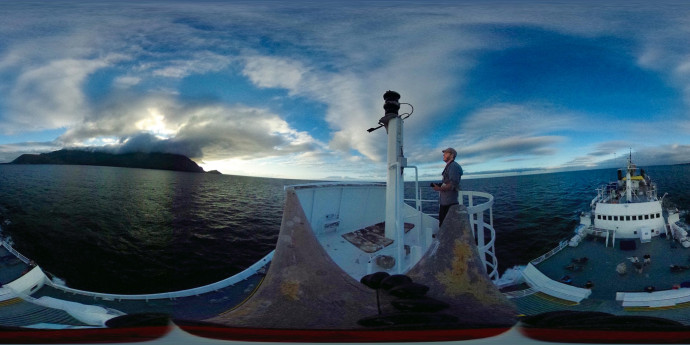
Jesse Lowes has always been an explorer. That explains, in part, how the seventh-grade science teacher at Portland’s Catlin Gabel School found himself, along with one other educator, 3,000 miles from home as a National Geographic Grosvenor Teacher Fellow bound for the Galapagos Islands.
More than 2,700 teachers from all over North America applied for the opportunity to participate in the 2015 National Geographic Grosvenor expeditions. Only 35, including Lowes, were selected.
Named for Chairman Emeritus Gilbert Grosvenor of the National Geographic Society and Education Foundation Board—and funded by a generous gift from Sven Lindblad, president and founder of Lindblad Expeditions—the program enables K-12 educators to participate in expeditions to some of the wildest and most geographically significant places on the planet. The primary mission is for educators to develop curriculum to communicate the power of geography and the value of conservation to students and the broader community.
Each expedition typically includes an expedition leader, an undersea specialist, and six to eight naturalists. Prior to the expedition, all the teacher fellows travel to Washington, D.C., to participate in a prevoyage workshop.
“At one point, I sat at the table where the National Geographic Society was founded and ate dinner with the society’s geographer, the man who mapped Cuba,” says Lowes, his voice rising in excitement recalling the weeklong training in the nation’s capitol. “But the greatest thing was the fabulous cross-pollination that occurred. I met teachers from all over North America.”
Lowes’ Wonder Everywhere blog,
September 18, 2015
Over the next eight days, I will be exploring the islands on foot and by boat … snorkeling, attending lectures, developing lessons, carrying out research projects, and learning as much as I can about the unique and curious land (and waters) that are the Galapagos. My head is spinning….
Lowes’ curiosity and love for all things natural were spawned early in the forests of his childhood home in rural Vermont. “I spent a lot of time tromping around exploring and trying to figure out patterns in the woods,” he says. “I didn’t know I was doing science, but I loved it.”
In high school, biology and environmental science teachers helped fan his passion. During his senior year, he conducted independent research on lichen as bioindicators for air pollution. “All of my results were inconclusive,” he laughs. “But the experience hooked me.”
An undergraduate degree in biology from Colorado College followed, as did field research on peregrine falcons and a study abroad program in Tanzania researching ants. He taught English in South Korea and outdoor school in California.
But he was searching for his niche.
September 21
Las Encantadas was the first name given to this improbable land…. We have not yet been here for two full days, and already I am enchanted.
We have ventured onto three islands … threaded our way through cacophonous frigate bird and blue-footed booby colonies, contemplated the life of land iguanas … and even spied a lone flamingo poised one-legged in a shallow lagoon. We have snorkeled alongside Pacific green sea turtles, surgeonfish, and manta rays in the deep waters … I have even managed to sleep a little in between.
Lowes relocated to Portland and landed a job as an outreach educator with the Oregon Museum of Science and Industry (OMSI). “It was a cool job,” he recalls. “For two years, I drove around in a big van filled with science equipment and presented to schools all over the western U.S. from Alaska to California.”
Despite the travel, the freedom, and the opportunity to teach science, something was still missing.
The absent ingredient struck him like a lighting bolt.
“I realized I wanted to get to know students as people and see their growth,” he says. “I love science and learning with people, but it’s the relationships you build with students over time that make learning and exploring science meaningful.”
That realization brought him to Lewis & Clark’s Graduate School of Education and Counseling.
Learning by Doing
September 23
Wherever you are, there is a compelling geographic story to be read within the elements of the every day. Yet, there are special times (in special places) when you may experience the exceptional—if you take the time to look. Today was one of those times.
Lowes was drawn to Lewis & Clark not only because of its excellent reputation, but also due to a friend’s recommendation. “It’s this strange, funny coincidence,” he says. “I met a friend from Portland at Colorado College. He’d attended Catlin Gabel. While I was globetrotting and teaching in various capacities, he knew he wanted to teach science and went through the Lewis & Clark graduate program in education three or four years before me. When I moved to Portland and began the OMSI job, my friend said, ‘You need to check out the program at Lewis & Clark.’”
While studying at the graduate school, Lowes says sometimes he wished his professors would “just hand me a toolbox and say, ‘This is what you need to know to teach.’”
It wasn’t that way and, in hindsight, he’s grateful.
“They gave us theories grounded in pedagogy and practical experience with other teachers,” he says. “They allowed us to try things out, stumble, and even fall. They encouraged us to be reflective and engage with one another about our decisions. There was wisdom in that because education needs to be a nimble, adaptable vehicle. We need to be able to change course with our students along the way.”
In the four years he’s taught at Catlin Gabel, Lowes has developed a style that combines both classroom and in-the-field teaching and learning.
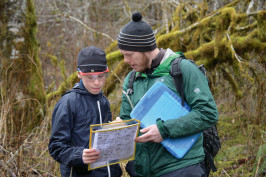
One of the outdoor learning opportunities he’s developed involves taking his students into the Hyla Woods experimental forest, a private, family-owned sustainable forestry operation in the northern Oregon Coast Range about an hour from Portland.
Today it’s raining sideways in the forest, but Lowes’ seventh graders, clothed in rubber boots and raincoats, are unconcerned about the wet conditions. They’re too busy filling jars with water, collecting plant samples, and taking notes to worry about a little dampness.
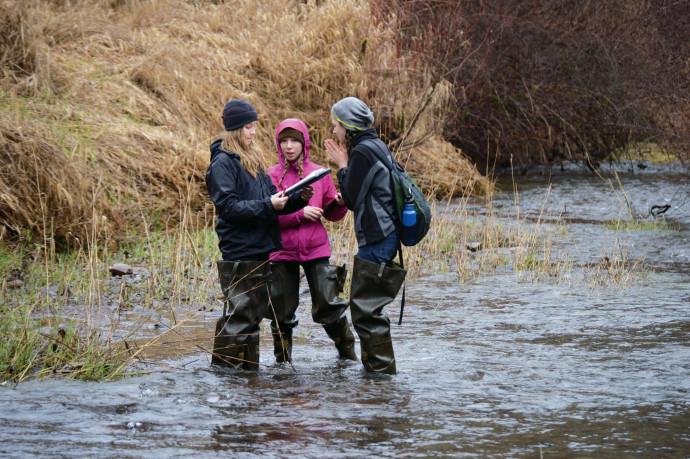
Lowes brings his classes to Hyla Woods about a half dozen times a year to conduct field research on the health of the forest. “You can imagine the logistics; it’s quite an ordeal,” says Lowes, laughing when a student runs up to show him a slimy, wiggly newt. “We spend a lot of time outdoors, and there are lots of wet boots.”
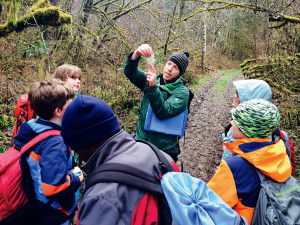
“This is place-based education,” explains Lowes. “It’s work that’s rooted in students’ sense of place. It’s about where they live, and it has meaning for them.”
The concept of place-based education was first introduced to Lowes by Greg Smith, professor of teacher education at Lewis & Clark’s graduate school. It has dramatically influenced Lowes’ teaching.
“Greg is a real gem, one of the most inspirational teachers I’ve had,” says Lowes. “He’d engage us in meaningful conversation and remind us that the role of education is to connect our students to people, to ideas, and to the concept of a different and better future for the planet.”
Lowes also points to Lewis & Clark instructor Jerry Kuykendall and Assistant Professor Dyan Watson (aka “Dr. DW”), both in the Teacher Education Program, as influential. However, it was Smith, he says, who helped firmly plant his feet in place-based education, encouraging him to use the lens of what’s outside the door to teach students about the local and global environment.
“Jesse was especially interested in place- and community-based education,” says Smith. “He regularly attends meetings of an informal network I created, Place-Based Education Northwest, and incorporates elements of this approach into his own work.”
Making Connections
September 25
Life has been full aboard (and off board) the Endeavour … so busy that it has been difficult to find the time to write. Days have been spent exploring the islands immersed in conversations with naturalists, embarking on deep-sea snorkeling excursions to better understand the marine ecology, and collaborating with the other NG Grosvenor Teacher Fellow (Mike Presser) on a very exciting digital storytelling project we’ve come up with … to share our lessons from the Galapagos with our classes and the world.
Lowes stands in front of five boys and four girls. It’s Catlin Gabel’s activity period for middle schoolers, time for teachers to offer different kinds of hands-on learning opportunities. Lowes has invited this group of students to try out an activity about shadows he dreamed up while on expedition in the Galapagos. “We’re going to talk about the geography of shadows,” he says.
He quickly flips through a mini presentation of photos and route maps about the Galapagos expedition, reminding them where the islands are located in relation to the equator. He stops at a photo of himself on the ship Endeavour at high noon, standing in a little puddle of his own shadow. “What does this shadow tell you about this place? What can shadows tell you about your place on the Earth and the Earth’s place in space?”
The students don’t need encouragement to begin excitedly talking with one another.
“What affects the shadow? Who’s got some ideas?” he prompts.
“How tall you are,” suggests one. “Where the sun is,” offers another. “The time of day.” “The season.” “The Earth’s axis and orbital location.”
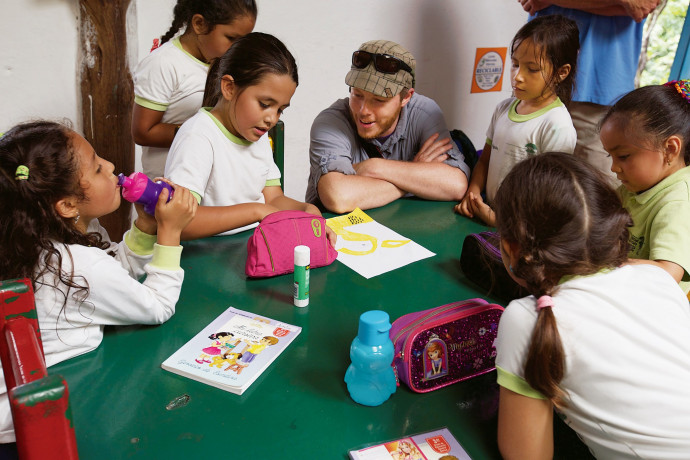
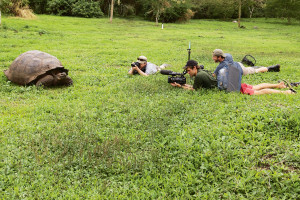
“Where would you have to be on the circle for us to take the photo I showed you? What does it tell you about where I was?”
The students move their Styrofoam models around the circle, tossing out ideas. “No, you’ve got to keep it pointed towards north,” says one. “I think this is where it’s the same.” “We’ve got to move it here.”
Lowes deftly navigates between addressing the group and working individually with one or two students. In the end, he clears the board of all but one Earth model, and together they find the sweet spot where the shadow replicates the one on the Endeavour. “That’s it,” exclaims one student. “It’s noon, on the equator during the equinox.”
September 28
One week and 600 miles later, we have arrived at our final destination. There are notes to take, photo and video files to swap, bags to pack, a blog to update, and lessons to plan. But there is also an open sky and the need for some final moments on deck… . There is a balance to be struck between the busy and the still.
Lowes is brimming with ideas about how to incorporate his Galapagos experience into his teaching. He’s already given two all-school presentations for students, teachers, and parents—and more are in the works.
He’s especially excited about the videos he shot with Mike Presser, a history and geography teacher from Riverside, California. They used a special 360-degree camera from National Geographic.
“The 360-degree camera can be used to create a virtual field trip,” says Lowes. “These two- to three-minute videos will let me not just talk about the Galapagos, but put my students right there.”
It’s important, he says, to make connections between faraway places like the Galapagos and where students live. “In our geology unit, for instance, we can compare and contrast the igneous origins of Mount St. Helens and the Galapagos. That enables me to tell a compelling story about a unique and lesson-rich corner of the world while connecting it to our work here.”
He gazes thoughtfully out at a darkening sky and says softly, “It’s at that point of connection where the magic really happens.”
To check out Jesse Lowes’ blog, visit https://wondereverywhere.wordpress.com.
Award-winning writer Bobbie Hasselbring is a frequent contributor to the Chronicle.
More L&C Magazine Stories
Lewis & Clark Magazine is located in McAfee on the Undergraduate Campus.
MSC: 19
email magazine@lclark.edu
voice 503-768-7970
fax 503-768-7969
The L&C Magazine staff welcomes letters and emails from readers about topics covered in the magazine. Correspondence must include your name and location and may be edited.
Lewis & Clark Magazine
Lewis & Clark
615 S. Palatine Hill Road MSC 19
Portland OR 97219

